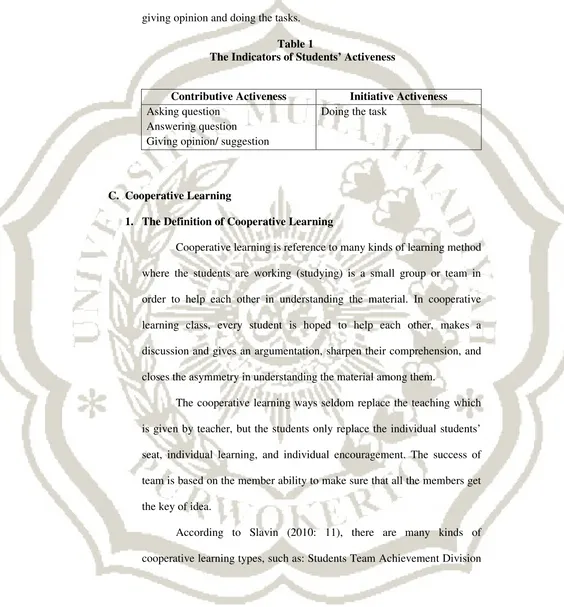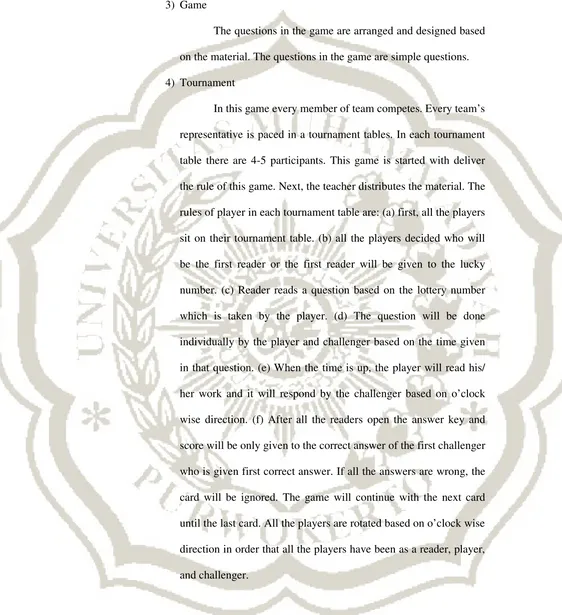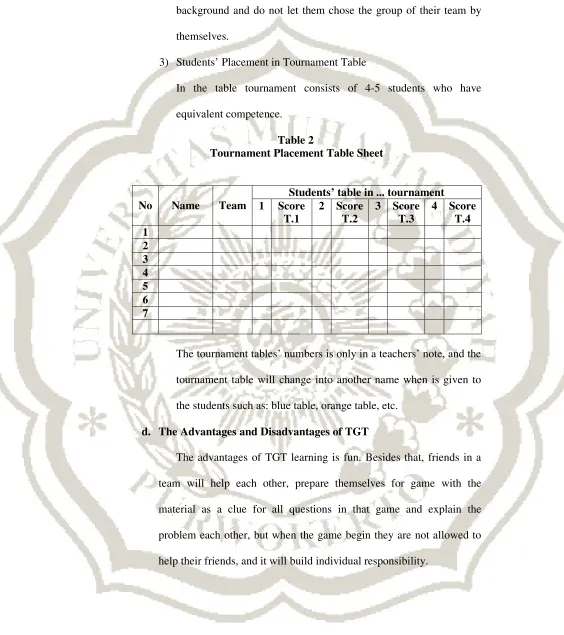CHAPTER II
LITERATURE REVIEW
A. Reading
1. The Definition of Reading
Reading is something crucial in our life. As defined by Ramelan (1990: 1), reading plays a very important part in our life. Through reading, we can explore the world, countries that have never been visited before, and the minds and ideas of greater people in the past, all of which will enrich our experience and knowledge, and broaden our horizon. To students, reading is also something crucial and indispensable since the success of their study depends for the greater part on their ability to read. If reading skill is poor, they are very likely to fail in their study or at least they will have difficulty in making progress. On the other hand, if they have a good reading ability, they will have a better chance to success in their study at school.
interactive process between the reader, the text, and the writer’s ideas to get some perception. Meaning is not only the mind of person doing the reading. It is the interaction between text being read and a reader that have the same texts, they may explain or interpret an identical text in different ways. They have different knowledge and expectations. In the other word, they have different reading skill.
Based on definition above, the writer concludes that reading is the process of understanding and interpretation to get of the printed message or written text.
2. The Importance of Reading
Reading is very important in study and society because there are many books, reference, and instructions etc, which are written in English. Thus, the students who have less reading competence will have difficulty to understand them.
Ramelan (1990) states:
From the statement above, it can be concluded that reading is very important for students either at school or after they graduate from their study. According to Clark (1987: 56) and Ramelan (1990: 1), reading will be of much use for students. By reading lost of literary works on various kinds of subjects, their mind will be more develop in maturity. Reading is also the one key to achieve the success of education. Incapacitating to read make something around us to be strange.
Reading is the main skill to reach a successful study. Students who continue in what their teacher gives in the class without having an effort to read many references will not pass in time and success. There are four points in the importance of reading as ways the successful study, as follows:
a. Reading is more the most full learning source b. Reading is the cheapest learning source c. Reading is the easiest learning source d. Reading is an up to date source.
3. The Purposes of Reading
a. Reading for Details or Facts
The students read the text to get or know the inversion that have been done by the writer or solve the problems of the writer.
b. Reading for the Main Idea
The students read the text (books) to know “why is the topic is good or interesting, then the problems on the passage, and make summaries of the passage.
c. Reading for the Sequence or Organization
The students read the text to know “what is happening in each part of the passage in every episode and solving the problems of the text”.
d. Reading to Classify
The students read the text to classify some information or actions of the writer in the text or paragraph.
e. Reading for Inference
The students read the text in order to find out the conclusion from the actions or idea in the text.
f. Reading to Compare or Contrast
4. The Kinds of Reading
People sometimes think that reading is only a process for getting information in written form, however reading has many purposes. Gie (1994: 61-63), says that in general of life, reading is divided into three kinds. They are
a. Entertainment Reading
It is about stories such as in novel or entertainment magazine. It is in series reading from the first until the end of the story. The aim is to enjoy the story and to appreciate the writer ability in make a plot of story so it is a beautiful roundness, ended or reach climax. It is easy to do because it doesn’t need special knowledge background. The story is about daily event; commonly the plot of the story following time sequence and it doesn’t include abstract meaning that needs technical term.
b. Glancing Reading
It is quick reading and sometimes followed by jump reading. It is done from the front to the back or by crisscross. The aim is to get illustration for a second about the content of the text and to find the information that reading is looking for in the text.
c. Study Reading
repeated for several times. The aim is to catch, understand and remember some knowledge in a science branch.
5. The Activity Types of Reading
In reading, there are some activities. Greenall and Pye (2005: iii), say that the micro skills for reading are developed using a variety of different activity types such as:
a. Extracting Main Idea
It is important to help the learner to look for the main ideas of a passage and to avoid getting distracted by unfamiliar vocabulary. Typical of a passage which develop this skill is matching exercises; text with picture, text with heading, etc.
b. Understanding Text Organization
It is sometimes difficult to understand what information is important is a passage and where it should come. Text organization activities help the reader to see what belongs to a passage, and how sentence are joined together in a logical way.
c. Inferring
d. Predicting
Before learners read a text, it may be helpful to encourage them to look at the subject or the title of the passage, and to think about the possible content. But remember,it doesn’t matter if the learners do not predict correctly. The activity still helps prepare them for reading.
e. Dealing with Unfamiliar Words
Actually in some texts, there will be many words which the learner will not understand. This is because all the passages are examples of real-life written English. It is important to try and guess the general sense of a difficult word, and there are a number of activities which help the reader deal with unfamiliar vocabulary without using dictionaries or asking the teacher to explain or translate.
f. Reading for Specific Information
We sometimes read to find the answer to a particular question, and not to understand the general sense of the passage.
g. Linking Ideas
Often a writer uses several different words to describe the same idea. Sometimes the use of a pronoun, for example, may be confusing, although the context usually makes the meaning clear.
h. Evaluating the Text
i. Reacting to the Text
In order to engage the readers’ interest in a text, it is useful to encourage them to react in a more subjective way to, for example, its humor or its literary and poetic appeal. The readers’ reactions to other text types, such as instructions, may be registered by them carrying out the instructions and demonstrating their comprehension in a non-verbal way. This skill may also develop their ability to supply missing context and information about the text.
In this research, the writer uses some activity types of reading: inferring, dealing with unfamiliar words, and reading for specific information.
In this research, the writer also chooses texts which are appropriate to the VIII Grade Students of Junior High School: narrative text.
B. Activeness
1. The Definition of Activeness
Being active is being participative. According to Hermawan in Hidayah (2011: 14), students’ activeness in teaching learning process is not only constract their own knowledge. They are active in building understanding of anything that they are face in teaching learning process.
sensation, but also give the feedback and positive response to the teaching learning process.
Therefore, activeness is doing something energetically and rapidly. A student is active when the students are able to respond the teaching leaning process. It is not only active in class (active in doing something out of the teaching learning process), but the activeness is correlated with the teaching learning process.
2. The Criteria of Students’ Activeness
The students’ activeness can be seen from their participation and cooperation in studying in the classroom. According to Imriskova in Falasifah (2010: 17), there are eight criteria to make students active in the class. First, teacher must be creative, invent new strategies and adapt existing ones to your needs. Second, teacher develops a plan for an active learning activity in the class, try it out, collect feedback, then modify and try it again.
Third, teacher gives frequent, early, positive feedback that supports students’ beliefs than they can do well. Fourth, teacher ensures opportunities for students’ success by assigning tasks that are neither too easy nor too difficult. Next, teacher helps students find personal meaning and value in the material.
learning community. The last, teacher request students to vary their seating arrangements in order to increase their changes to work with different people. Students occasionally pair up with the students behind them since the students often sit with his/ her friends side by side.
Based on the criterions above, the writer concludes that teacher must be able to apply those criterions in order to make teaching and learning process alive. Based on Hopkins (1993: 1), there are eight considerations or eight criteria for active learning in the class. First, making students centered in the class. Second, getting students to participate in the class.
Third, promoting class participation, discussion among the entire class. Fourth, helping students learn more from teacher. Next, helping students master the vocabulary and definitions in a discipline quickly. Sixth, helping students to ask and answer the teacher’s questions. Then, helping students to give their opinion about the lesson given by the teacher. The last, helping all students to share in a pair and share exercise.
3. The Indicators of Activeness
Some points can be used to measurethe students’ activeness. The instrument of it is called indicator of activeness.
Suwartono in his journal (2011: 1-2) stated that:
“In the English learning process, students’ responses are one of the important factors supporting students’ achievement. It is generally believed that students’ responses influence both the students in following the learning process and the teachers in conducting the instructional process. Asking questions in the English classes is a form of positive responses from the students. Questions give focus and direction, and provide goals to both the teachers and the students. And when the students generate questions personally, the impetus for education is theirs”.
Based on the explanation above, the writer concludes that students’ activeness in the class such as: ask questions, answer question, give opinion, etc will support their achievement.
Suryosubroto in Hidayah (2011: 71), students’ activeness is low when the students do not ask questions, their activity are listening and writing only, they make a noisy when the teacher give an assignment, and they only silent whether they understand or not.
the descriptions above, those are: asking question, answering question, giving opinion and doing the tasks.
Table 1
The Indicators of Students’ Activeness
Contributive Activeness Initiative Activeness Asking question
Answering question Giving opinion/ suggestion
Doing the task
C. Cooperative Learning
1. The Definition of Cooperative Learning
Cooperative learning is reference to many kinds of learning method where the students are working (studying) is a small group or team in order to help each other in understanding the material. In cooperative learning class, every student is hoped to help each other, makes a discussion and gives an argumentation, sharpen their comprehension, and closes the asymmetry in understanding the material among them.
The cooperative learning ways seldom replace the teaching which is given by teacher, but the students only replace the individual students’ seat, individual learning, and individual encouragement. The success of team is based on the member ability to make sure that all the members get the key of idea.
(STAD), Team Game Tournament (TGT), Jigsaw II, Team Accelerated Instruction (TAI), Cooperative Integrated Reading and Composition (CIRC), Group Investigation, Learning Together, Complex Instruction, and Structure Dyadic Method. In this research, the writer wants to explain more about TGT.
2. Cooperative Learning Technique: Team Game Tournament
a. The Definition of Team Game Tournament (TGT)
Team Game Tournament is an academic tournament which uses quiz and individual improvement score system. Here, students compete as a representative from their team with another team (Slavin, 2010: 165-166). In general way, TGT is an academic tournament in which students compete as a representative from their team to be the best team.
Learning activity with games is created in Team Game Tournament. It is possible to make students relax and grow their responsible, cooperation, compete and learning involvement (Kiranawati in Hidayah, 2011).
b. The Component of TGT
Slavin (2010: 166), says that the prime components in TGT are: class presentation, team, game, and tournament.
Here are the explanations of each following term. 1) Class Presentation
Class presentation is used by teacher to introduce the purpose of learning, a short explanation about what should the students do to with the text and give them a time to understand about it.
During the class presentation students must be pay attention and understand the material from teacher because it will help them work in a team and in a game.
2) Team
3) Game
The questions in the game are arranged and designed based on the material. The questions in the game are simple questions. 4) Tournament
In this game, readers only reads question and answers key and can not be given to the other players. When all the questions are answered, the score will be counted. The last is giving award to the winner.
Figure 1
The picture above shows that students’ placement in the tournament table is based on their scores in team. The first tournament table is a table for students who get the highest score in the quiz, and also as the highest level than other tournament tables.
When the tournament is over, students take a table based on their score in the previous tournament.
c. Learning Preparation of Using TGT
To reach the sucessful of teaching and learning process, the preparation is needed before it. According to Slavin (2010: 169), the preparation in teaching using TGT covers material preparation, students’ placement in a team, team cooperation, and students’ placement in table tournament. Here are the explanations:
1) Material Preparation
Material preparation is designed in order to able to present in class, in cooperation, and in tournament. The plan is packed in a set of learning consists of lesson plan, teachers’ instruction book, students’ book, students’ worksheet, and tournament completeness (for example: provide cards from 1-25)
2) Students’ Placement in a Team
background and do not let them chose the group of their team by
The tournament tables’ numbers is only in a teachers’ note, and the tournament table will change into another name when is given to the students such as: blue table, orange table, etc.
d. The Advantages and Disadvantages of TGT
There are some advantages and disadvantages of TGT. The advantages are
1) Improving students’ confident
2) Improving students’ motivation in learning 3) Understanding the material well
4) Improving students’ kindness, sensitivity and tolerance 5) Easily to apply and cheap
The disadvantages are 1) It makes a noisy class
2) It takes much time in teaching learning process.
Teacher who disables to organize the class management, it will make a failure of TGT. Therefore, it is important to the teacher to motivate the students in actualize them selves and organize the time.
The characteristic of TGT to the other cooperative learning method is on the tournament and the function of tournament is to compare between the teams.
e. Teaching Reading Using TGT Technique
2) The teacher asks the students the date of today, and the number of the date will be the lucky number to the students who have the same presence number to be the first reader.
3) The first reader takes envelope which consists of one question and one key answer and reads the question and gives a chance to the reader’s team. The reader is not allowed to answer the question. If the answer is true, the card is given to that team as represents score in which the students can answer the question correctly. 4) If the other challengers have another answer, they are permitted to
show the answer (clockwise direction).
5) The game will be continued with the same procedure until all the questions in each envelope opened and answered.
6) When tournament is over, students count their card and accumulate the score.
7) For the next tournament, teacher is able to make a movement of students’ placement based on their achievement in tournament table.
D. Basic Assumption
The writer assumed that teaching reading using TGT would improve the students’ activeness. Through TGT, students could cooperate, and they did not think individually because they could share their ideas with other students.



